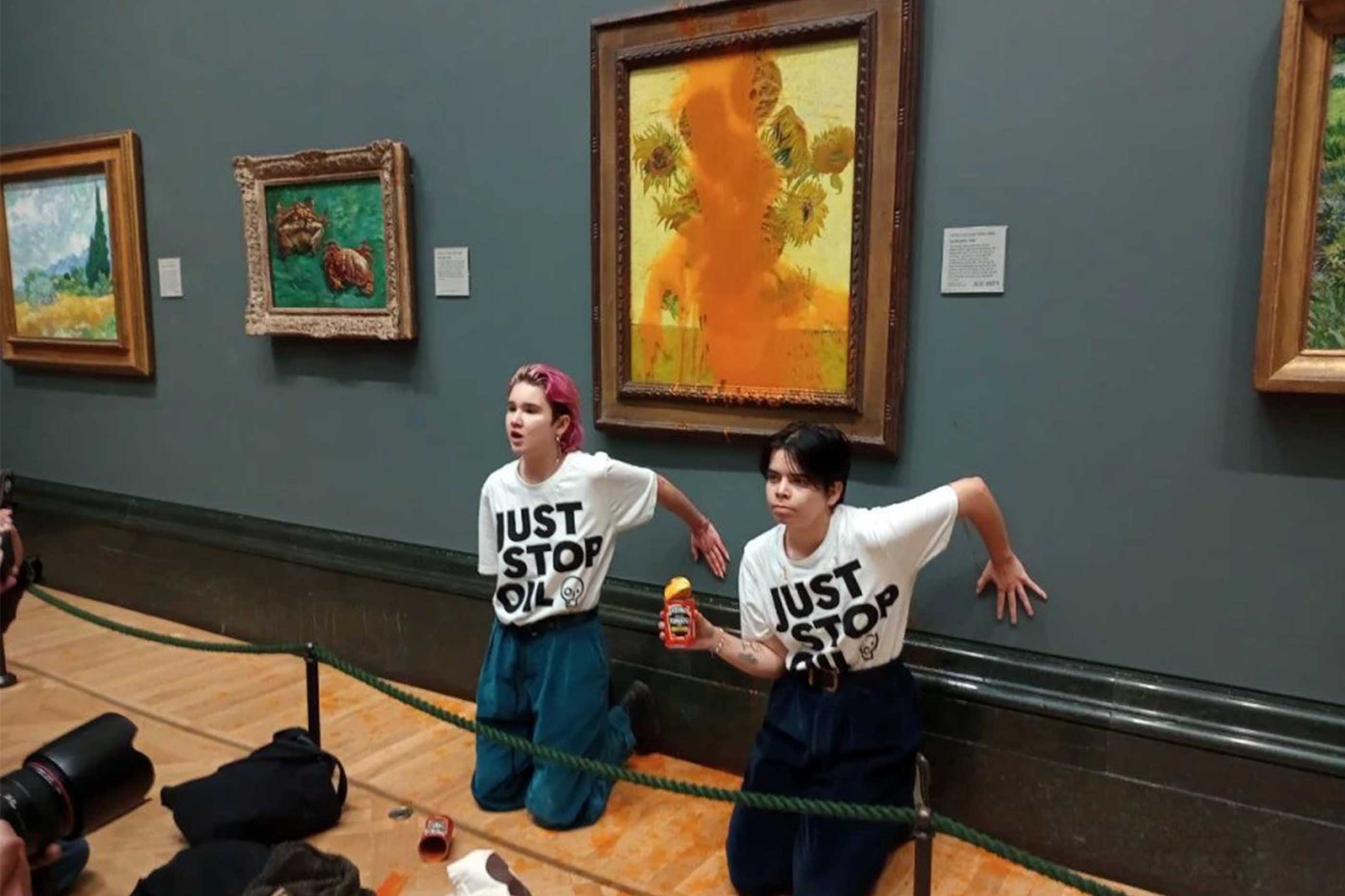
Last weekend I paid a visit to the Art Gallery of NSW, mostly because I had seen a video on Instagram of the gallery installing Ken Unsworth's Suspended Stone Circle II and was quietly hoping to catch a glimpse of Sydney Modern before its opening on December 3. The place felt different, for one its 20th Century Galleries had stretched out and reopened, all exhibitions (even Daniel Boyd's Treasure Island) were free, and most noticeably of all more bodies, dressed head-to-toe in monochrome, were on the ground than ever.
To anyone familiar with Just Stop Oil, the latter observation will come as no surprise. Galleries are understandably tightening security lest the artworks under their protection be splattered in Campbell's soup or iced with chocolate cake. These changes come following a series of high profile stunts targeting famous artworks were carried out by climate activists across the globe – ones who protest under the banner of Just Stop Oil.
What began with a couple of protesters emptying two tins of tomato soup on van Gogh's Sunflowers before supergluing their hands to the wall, spiralled into a precession of duplicate acts. In Norway, three activists attempted to glue themselves to Edvard Munch's The Scream, a symbol of existential angst. Then a Belgian activist duo were sentenced to a two month stint in prison after they glued their heads to Vermeer's Girl With The Pearl Earring. Elsewhere, others poured dark liquid on a Gustav Klimt painting, and in Potsdam, mash potato was slopped across Monet's Haystacks.
Australian galleries have seen their own fair share of Selleys too. On November 4, a woman walked into Parliament House and glued herself to the glass casing that surrounds a historical suffragette banner and almost a week later the same Western Australian permaculture farmer, Julie Marsh, stuck herself to a set of Andy Warhol's Campbell's Soup Cans. Although this time around she had a partner in crime, Bonnie Cassen, a mother of three who is currently undergoing chemotherapy for an "incurable cancer".
Cassen told The Saturday Paper that she is spending her last day fighting to protect the planet. "We only have a limited time," she urged. "I need people to stand up and join me."
Involving beloved artworks such as these in their protest has inflamed the internet and drawn intense criticism from both ends of the political spectrum. Admittedly, when I first saw the Sunflowers drenched in Berocca-coloured fluid, I thought it an act of violence. The tactics didn't measure up to the message and did they realise this would alienate rather than convince? Senior art critic at New York Magazine, Jerry Saltz, summed it up best in a 6-part Instagram carousel. "The protest hit me with a gut-punch, at art, an object that cannot protect itself, that I know heals people[...]"
But then I started reading and actually listening to the statements made by the protesters, especially something the man with his head stuck absurdly to Vermeer's portrait said, and it all began to make sense.
“How do you feel when you see something beautiful and priceless apparently being destroyed before your eyes?" He asks. “Where is that feeling when you see the planet being destroyed?”
In an interview with frieze, Phoebe Plummer and Anna Holland of the Sunflowers fiasco echoed this statement when explaining why they targeted van Gogh's beloved painting. "Van Gogh himself was a penniless artist. He lived and died in debt. If he’d been alive today under this government, he would have been one of those people who, this winter, would be forced to choose between eating or heating his home."
And they have a point. Just this year in the global south, (a region that will feel the blows of climate catastrophe the hardest), 33 million people in Pakistan were displaced by apocalyptic floods and at home, the central west is experiencing unprecedented flooding too.
Take a break from the pearl-clutching and internet rage and you'll see this is all part of the bigger picture; a collective effort to gather eyes ahead of November 6-18, when the United Nations COP27 Summit in Egypt would take place. Like its forerunners Extinction Rebellion, Just Stop Oil's tactics (which include cutting off traffic on London's M25 motorway for four days straight) are deeply unpopular, but if they yield results, isn't that a win for us all? After all, the UK faction of the environmental coalition is demanding the British government cancel plans to greenlight 40 new North Sea oil and gas fields. Meanwhile, Julie Marsh is a member of Stop Fossil Fuel Subsidies, a group that condemns the Australian government's spending of $11.6 billion last year to subsidise fossil fuel production.
For those who still take umbrage with the activists methods, I think you're forgetting that the combination of art and activism are as old as Adam. And both, if nothing else, have one thing in common; neither has to be palatable. Besides, when did we get to dictate the terms of protest? Watering down civil disobedience only waters down its effectiveness, which when the climate is concerned, does a disservice to us all.
More to the point, the destruction was completely symbolic; Van Gogh's Sunflowers is protected by glass, as is the rest of the paintings. Last time I checked, our planet is not. Unlike the case of suffragette Mary Richardson, who slashed Velázquez's The Rokeby Venus, the protestors at the National Gallery admitted they would've never gone through with the stunt if the painting wasn't protected and all of the artworks are free from any permanent damage. Both Pummer and Holland have also pointed out that, as queer people, the reason they are able to vote and someday marry the love of their life is because of similar acts of civil disobedience.
Other criticisms include the suggestion that it is a bourgeoisie thing to waste perfectly good cans of tomato soup, especially with the cost of living and inflation at an all time high. But one can of spent tomato soup is a trifle thing, especially when you realise that at the end of this year we will have reached the quarter-mark of a decade scientists agree will be critical to determine the future of life on this planet, and we're still bickering about the semantics of non-violent protest? Some have gone so far as to call climate activism a middle class hobby, but if the middle class are advocating for those in the global south, I would argue that is a good thing. And despite how much we bury our head in the sand and sulk about the act alienating us from the cause, the climate crisis is a burden we must all shoulder, and no amount of procrastinating will change that.
Then there are those that condemn the protestors for not thinking of the gallery cleaners that would be made to wipe up the mess, a position that holds merit, but not flagrant enough to turn away from the cause entirely. In the same corner, you'll find those hypothesising about how the legal repercussions would be different if the protestors were working class, and to this the answer is obvious; have we not been pleading for those with privilege to wield it in a way that's useful? This is what putting their necks on the line looks like in action.
The last thing I will say is that the question of whether stunts like these are actually effective has been put forward. What we know is that in the last year alone governments have cracked down on activist groups in an attempt to deter civil disobedience. The NSW government introduced harsher penalties, including fines of $22,000 and two years in prison, after Blockade Australia blocked off tunnels and motorways in Sydney earlier this year. Safe to say the environment around protesting is already hostile, and has shaped the approach of activists. In a post-pandemic world, smaller stunts are favoured over mass gatherings, and they're better at generating headlines, thus conversation and interest, directing attention to potentially bigger actions scheduled. Either way, it's been over a month and we're still talking about tomato soup. Action is better than none at all.
And if your concern still lay with the art, remember this: van Gogh's Sunflowers don't exist in a (very plausible) future of climate extinction.
Image: Twitter



